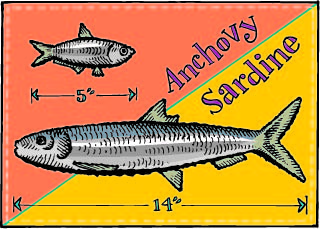If you've ever wondered whether sardines and anchovies are the same, you’re not alone. These two small fish often appear in recipes, supermarket shelves, and nutritional discussions. While they share similarities, they are quite different in taste, texture, and usage. Let’s dive into the world of sardines and anchovies to understand their distinctions and why they’re beloved staples in kitchens worldwide.

No, sardines and anchovies are not the same, even though they’re often confused for one another. Both are small, oily fish packed with nutrients, but they differ significantly in their appearance, taste, and culinary uses.
Sardines: These fish are usually larger, with silvery, shiny scales. They have a rounder body and are easily recognizable because of their reflective appearance.
Anchovies: Anchovies are smaller, slimmer, and darker in color. Their skin often has a more muted tone, with hints of gray or green.

Here’s a detailed comparison of the physical differences between sardines and anchovies presented in a table for clarity:
| Feature | Sardines | Anchovies |
|---|---|---|
| Size | Larger, typically 15–30 cm (6–12 inches) | Smaller, usually 5–15 cm (2–6 inches) |
| Body Shape | Plumper, rounder body | Slim, elongated body |
| Color | Bright silver with a shiny, reflective appearance | Darker coloration, often grayish-green or brownish |
| Head | Proportionally smaller compared to the body, with a less pronounced snout | Pointed snout, giving the head a sharper, more defined look |
| Fins | Clearly visible, with slightly broader pectoral fins | Smaller, less noticeable fins |
| Scales | Large, easily removable, and distinctly visible | Small, tight scales that may not always be obvious |
| Mouth | Smaller, positioned towards the front | Larger, with an extended lower jaw that gives it a slightly protruding mouth appearance |
| Tail | Forked, with a balanced and symmetrical shape | Forked, but narrower and more pointed |
| Overall Appearance | Flashy and robust, often considered visually appealing | Subtle, less shiny, and streamlined for a more understated look |
Key Takeaways:
Sardines are larger and flashier with a more robust, rounded body.
Anchovies are smaller, sleeker, and have a more pronounced snout and darker coloration.
This table highlights the distinctions, making it easier to identify sardines and anchovies at a glance.
Sardines: Known for their mild, slightly oily flavor, sardines are less salty and have a tender texture. They are often enjoyed whole, including their bones, which are soft and edible.
Anchovies: Anchovies have a strong, salty, and umami-packed flavor. They’re commonly cured, giving them a firmer and more intense taste that can overpower dishes if not used sparingly.
Sardines are versatile in recipes, whether grilled, added to salads, or served on toast.
Anchovies are a favorite for enhancing flavors in sauces, pizza, and even Caesar salad dressing due to their rich umami profile.
Not exactly. Sardines have a milder, less salty taste compared to anchovies, which are robust and intensely salty. If you prefer subtle flavors, sardines are your go-to. For those who love bold, savory notes, anchovies win every time.
Both sardines and anchovies are nutrient-dense, but they differ slightly:
Omega-3 Fatty Acids: Both are rich in omega-3s, but sardines generally contain slightly more.
Protein Content: Anchovies are protein-packed, making them a great option for muscle building and energy.
Salt Levels: Anchovies, especially cured ones, have higher sodium levels due to the curing process. Sardines are less salty by nature.
Mercury Content: Both are low in mercury, making them safe for regular consumption.
Yes, but with caution. Sardines and anchovies have different flavor profiles, so substituting one for the other will change the dish. Sardines work well as a milder replacement, while anchovies add a punch of saltiness and depth.
Grilled sardines with lemon and herbs are a classic Mediterranean dish.
Canned sardines make an excellent protein-rich topping for toast or crackers.
Mix sardines into pasta for a quick, nutritious dinner.
Anchovy paste is a secret ingredient in sauces like Caesar dressing and puttanesca.
They’re a classic pizza topping, adding a salty kick.
Melt anchovies into olive oil for a flavorful base for vegetables or pasta.
There are several types of sardines, including:
Pacific Sardines: Commonly found in the U.S., known for their larger size.
European Sardines: Popular in Mediterranean cuisines.
Anchovies vary by region, with the most famous being:
European Anchovies: Found in the Mediterranean and often salted or canned.
White Anchovies: A milder, fresher-tasting variety, often used in gourmet dishes.
Both sardines and anchovies are considered sustainable seafood options. They reproduce quickly and are harvested in a way that minimizes ecological impact. Check for certifications like MSC (Marine Stewardship Council) to ensure ethical choices.
Sardines: Commonly canned in oil, water, or tomato sauce. They can last up to 2 years in a sealed can.
Anchovies: Often cured with salt and packed in oil, anchovies have a longer shelf life but are highly perishable once opened.
Refrigerate opened cans and consume sardines within 2-3 days.
Anchovies can be stored in oil for a few weeks after opening but should be kept airtight.
Both are excellent sources of nutrition, but your choice may depend on dietary preferences:
Choose sardines for a milder taste and slightly more omega-3s.
Opt for anchovies for a flavor-packed addition with high protein.
Sardines are named after the Italian island of Sardinia, where they were once abundant.
Anchovies were a prized delicacy in ancient Rome, used to make garum, a fermented fish sauce.
Both fish are featured prominently in Mediterranean and Asian cuisines.
While sardines and anchovies may look similar, their differences in flavor, texture, and culinary applications make them unique. Whether you enjoy sardines grilled or anchovies as a salty flavor booster, both have their rightful place in your pantry. Try experimenting with both to discover which suits your taste buds best!
This comprehensive guide covers everything you need to know about sardines and anchovies. Whether you're a foodie, a health-conscious eater, or just curious, there’s always something fascinating about these tiny yet mighty fish!
animal tags: Sardines Anchovies
We created this article in conjunction with AI technology, then made sure it was fact-checked and edited by a Animals Top editor.